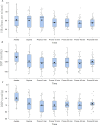Effect of prone position on cerebral hemodynamics and noninvasive intracranial pressure assessed using transcranial Doppler in patients undergoing spine surgeries: a prospective observational study
- PMID: 40375147
- PMCID: PMC12079893
- DOI: 10.1186/s12871-025-03116-9
Effect of prone position on cerebral hemodynamics and noninvasive intracranial pressure assessed using transcranial Doppler in patients undergoing spine surgeries: a prospective observational study
Abstract
Background: The prone position, frequently used in spine surgeries for optimal surgical access, induces physiological changes in cardiovascular and respiratory parameters. Increased intraabdominal and intrathoracic pressures lead to elevated central venous pressure (CVP). Along with raised intrathoracic pressure, positive end-expiratory pressure (PEEP) results in elevated CVP, impeding venous blood flow from the brain and potentially affecting intracranial pressure (ICP).1 Transcranial Doppler (TCD) ultrasound is a non-invasive method commonly used to measure cerebral hemodynamic parameters, including peak systolic velocity (PSV/ MCAvpeak), mean flow velocity (MFV/MCAvmean), pulsatility index (PI) and resistivity index (RI), which are associated with cerebral vascular resistance, intracranial pressure, and cerebral perfusion pressure (CPP).
Method: Thirty-three patients undergoing spine surgery were assessed. The vital and TCD parameters PSV/MCAvpeak, MFV/MCAvmean, PI, and RI were noted in the supine position. (Ta). General anaesthesia was administered, and TCD measurements were repeated after induction. (Ts). Patients were then positioned prone, and TCD measurements were repeated at intervals Tp0 - immediately after the prone position, Tp15 -15 min of the prone position, Tp30 -30 min, Tp45 -45 min and Tp60 - 60 min. Vital parameters were noted at the above-mentioned time points. Non-invasive ICP (nICP) was calculated.
Results: There was a statistically significant decrease in the heart rate (HR) compared to the supine position at Tp45 and Tp45 as compared to Tp0. There was a statistically significant decrease in systolic blood pressure (SBP) as compared to Ta at Tp0 (p < 0.001), Tp15 (p < 0.001), Tp30 (p = 0.003), Tp45 (p = 0.001), and Tp60 (p = 0.018). The study found no statistically significant changes in cerebral hemodynamic parameters (PSV/MCAvpeak, MFV/MCAvmean, PI and RI) and nICP at various time points.
Conclusion: Our findings suggest that the prone position does not cause significant changes in cerebral hemodynamics and nICP.
Trial registration: CTRI/2023/06/053677 dated 08/06/2023.
Keywords: Non-invasive intracranial pressure; Prone position; Pulsatility index; Spine surgery; Transcranial Doppler.
© 2025. The Author(s).
Conflict of interest statement
Declarations. Human ethics and consent to participate: This study was approved by the Institutional Ethics Committee of AIIMS Bathinda (letter No. IEC/AIIMS/BTI/301; Dec 2022) and commenced after registration with the Clinical Trial Registry of India (CTRI/2023/06/053677 dated 08/06/2023). (Letter attached). All study related procedures were performed in accordance with relevant guidelines and regulations. Written informed consent was taken from all patients willing to participate in the study. Consent for publication: Not applicable. Details of previous presentation of the work: Presented at 12th EURONEURO - Brussels November 5–7, 2023 as a poster titled “Effect of prone position on cerebral hemodynamics assessed using transcranial doppler in patients undergoing thoracolumbar spine surgeries: a preliminary analysis.”. Presented at SNACC 2024 Annual Meeting (Virtual presentation) held from September 12–14 in Denver, Colorado, as a paper titled “Impact of Prone Position on Intracranial Pressure in patients undergoing Thoracolumbar Spine Surgeries as Assessed by Transcranial Doppler.” Competing interests: The authors declare no competing interests.
Figures



References
-
- Edgcombe H, Carter K, Yarrow S. Anaesthesia in the prone position. Br J Anaesth. 2008;100:165–83. 10.1093/bja/aem380. - PubMed
-
- Pump B, Talleruphuus U, Christensen NJ, Warberg J, Norsk P. Effects of supine, prone, and lateral positions on cardiovascular and renal variables in humans. Am J Physiol Regul Integr Comp Physiol. 2002;283:R174–180. 10.1152/ajpregu.00619.2001. - PubMed
-
- Heilbrun MP, Jorgensen PB, Boysen G. Relationships between cerebral perfusion pressure and regional cerebral blood flow in patients with severe neurological disorders. Stroke. 1972;3:181–95. 10.1161/01.str.3.2.181. - PubMed
Publication types
MeSH terms
LinkOut - more resources
Full Text Sources
Research Materials
Miscellaneous

